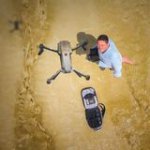-
Posts
778 -
Joined
-
Last visited
Content Type
Profiles
Forums
Articles
Everything posted by Robert Collins
-
As I recall, the newest technology between pdaf sensor arrays, cdaf and on-sensor pdaf is on-sensor pdaf (starting with Nikon 1?) which is where most of the progress has been made over the last 5 years. The problem is that Panasonic has refused to adopt this technology and has disappeared down a long dark rabbit hole of DFD which is essentially marrying cdaf with 'proprietary' lens profiles....
-
This lens rather neatly shows why Panasonic is heading into FF. It is a big heavy, expensive fast zoom designed to appeal to those users that see the need to make up for the lack of light and DOF inherent in a smaller sensor. At some point you inevitably conclude that a larger sensor makes more sense.
-
Arent you confusing sensor sizes here when you say ' It appears to have the amazing Sony 100MP CMOS sensor we last saw in the Hasselblad H6D 100C'? The Fuji GFX series has 44 x 33mm sensor size which is sort of 'mini medium format' with about half a stop and 20% extra resolution than FF while the Hasselblad H6D uses a 54 x 40mm sensor which is well over a stop larger than FF.
-

Panasonic announcing a full frame camera on Sept. 25???
Robert Collins replied to Trek of Joy's topic in Cameras
Well sort of. But we do now have 20 different live mounts selling a total of just 10m ILCs. As Thom Hogan says 'I see dead mounts....' http://www.dslrbodies.com/newsviews/i-see-dead-mounts.html -

Panasonic announcing a full frame camera on Sept. 25???
Robert Collins replied to Trek of Joy's topic in Cameras
I guess so. Never seen one in the wild though.... -

Panasonic announcing a full frame camera on Sept. 25???
Robert Collins replied to Trek of Joy's topic in Cameras
A Panasonic camera for photographers?! Well that is a novel concept. -

Panasonic announcing a full frame camera on Sept. 25???
Robert Collins replied to Trek of Joy's topic in Cameras
I watched a bit of it but I missed all the video specs. What were they? -

Panasonic announcing a full frame camera on Sept. 25???
Robert Collins replied to Trek of Joy's topic in Cameras
I am not sure this will really work. Sigma tried to create FE mount versions of its lenses by essentially swapping the EF mount with an MC-11 adaptor rather than actually redesigning the lenses and including step motors that are fairly essential to the efficient use of CDAF. The result is that they dont focus particularly well on the FE mount. It is likely that the SL mount wont have PDAF at all which would make them less suited without a redesign. -
A little harsh. I actually think that both Max's and Phillip Bloom's video reviews are pretty good. I think it is important to take Max's review in context. He already owns a P4P with a one inch sensor (capable of 4k 60) and the M2Pro probably doesnt offer any significant IQ advantage over that. He also owns a Mavic Air which is more portable than a M2Pro and offers better image quality than the original Mavic Pro (due to less in camera sharpening/NR and better codec.) So coming from that context, I can see why he concludes that a M2Pro doesnt have enough value added for him to keep it. Now, if like me, you only own a single drone and are upgrading from an original Mavic Pro, then M2Pro is a HUGE upgrade. Better image quality, better codec, better compression (h.265 v h.264), better bit depth (10 bit v 8), better bit rate (100 v 60), better stills (20 v 12mp), better battery life, more sensors, variable aperture, better build quality etc... Of course, it would have been nice to have 4k 60p and a 4k full sensor readout but there you go. And anyone who really expected something special out of the camera simply because it has Hasselblad on the front was simply being heroically optimistic. We are sort of in the 'hangover' phase after the initial release where all the relatively small problems with a camera are highlighted (remember pdaf stripe gate, and line of dead pixel gate with the A7iii.)
-
I would assume it is a Sony sensor (custom built for Fuji) but I guess we will eventually find out. Most of the rumors about the A7000 (or whatever its name is going to be) suggest that it will be a sensor using Sony's stacked cmos technology only previously seen on the Sony A9 (which is why the camera is sometimes referred to as a 'mini A9'). This will enable very fast sensor readout which should result in very high frame rates and virtually zero 'rolling shutter' (even with a fully electronic shutter.) So, when it is released, the specs of the A7000 should upstage the XT-3.
-
Great stuff. Makes me want to go there - never been....
-
If you think about it - a camera (as in say the A7iii) which has a base iso of 100, why would it really choose to shoot SLOG at an iso of 800 (lets forget about the dual iso bit for the moment)? If it did so, it would effectively reduce dynamic range by close to 3 stops and increase noise by close to 3 stops. The answer is it doesnt record slog at iso 800 but at iso 100 and therefore you have to 'overexpose' to 'expose' correctly by +2EV+. (I think the situation is pretty similar with the Panasonic GH5. Its native iso is 200 but it records log showing iso at 400. Something like that.) Why Sony does this I really dont have a clue - someone suggested it was something to do with maintaining compatibility with cinema cameras which have a higher inherent base iso.
-
Actually SLog on Sony cameras is something of a special case. While the camera says it is recording at 'iso800' it is in fact recording at base iso 'iso100' so footage is bound to be underexposed irrespective of the underlying log curve.. You can see this by analysing the underlying metadata. Supposedly Panasonic cameras do something fairly similar but with only a one stop difference.
-

Panasonic announcing a full frame camera on Sept. 25???
Robert Collins replied to Trek of Joy's topic in Cameras
That must be Leica's contribution to the joint venture.... -
Personally, I dont think there is an underlying problem here. The drone is pointed almost directly into the sun - the brightest possible light source and the bottom left (especially) is shielded from the sun and receiving very little light. There could easily be 30 stops of dynamic range in this screenshot - which might look good to our own eyes but wont look good to a 1 inch sensor (especially with video.) If you look around you will see plenty of sunset/sunrise videos taken with something like a Mavic and they tend to look pretty terrible because in order to get decent detail in your shadows you have to blow out your highlights. As an example here is a screenshot of a photo taken with the A7riii in raw (which obviously has a lot more DR than a Mavic sensor.) The red areas show the clipped highlights and the blue shows the shadows with no detail - the shot is obviously unusable. Typically you cant get decent video from a Mavic shooting directly into the sun.
-
Yes, you are absolutely right there. If you have no intention of editing your footage there is absolutely no point in either 10 bit or DLog - just shoot normal mode 8 bit. The point that I found 'interesting' was that 'you could shoot 10 bit DLog with h.264' as opposed to 'h.265'. Why would you want to do that when h.265 should theoretically give you more 'info' - well purely for 'ease of editing'. I thought you needed to shoot h.265 for 10 bit and DLog.
-

Panasonic announcing a full frame camera on Sept. 25???
Robert Collins replied to Trek of Joy's topic in Cameras
The situation with the Sony FE mount and Sigma FE lenses is a bit strange. Sigma, rather than redesigning the lenses (and af motors) for mirrorless, simply effectively just stuck an MC11 adapter on the back of their DSLR lenses. This made the lenses overly large and with poor focusing. So the Sigma FE line of lenses have been largely ignored by Sony users even though they are quite cheap. I do think that Sony lenses are quite expensive and that the system is crying out for decent reasonable budget options like the Tamron 28-75 2.8. I thought Canon and Nikon were going to come in and compete aggressively on the price of their optics but it appears they want to go the premium route too. And then Canon and Nikon's decision to not license their mount to thrid parties also seems somewhat backward.... -
But isnt 'electronic stabilisation' just something that you can do in post (with a much more powerful processor)? Mechanical stabilisation aka ibis or say DJI Mavic gimbal is stabilisation that works before PP.
-
I am looking forward to the DJI offering....
-
Interesting video...
-

Panasonic announcing a full frame camera on Sept. 25???
Robert Collins replied to Trek of Joy's topic in Cameras
I think we will find that Panasonic's jump to say 50mp is mostly driven by a desire to maintain M43's backward compatibility with 4k video. But I agree that a new Panasonic FF mount is going to be a really hard sell with a US$3k camera and no pdaf or ibis. Even if it is a really good camera - is the general consumer going to buy into this mount? Remember the NX1 - great camera - but there was little general confidence in the mount and it just didnt sell. -
My guess would be that Samsung will be back in the image sensor business for ILCs one way or another within a couple of years. There are likely to be too many opportunities. And in all likelihood Canon will be out of the image sensor fabrication business within 5 years and bring the major consumer in the market to the table. Their sensor fabrication business has been in decline for a long time and if anything their tech is moving further and further behind Sony.
-
Sure. Noone would disagree that a phone offers far more functionality than any camera. 'But it occurs to me that the major 'delta' between a US$500 phone and a US$1200 phone is usually sold pretty much based on the camera. By that I mean it has been a long time since someone said I bought an iphone over an oppo because its mobile calls have much better reception or it has higher data internet speeds or even much better screen/processor speed/speakers/battery etc.. Premium phones are pretty much sold on the back of their cameras these days -with the likes of Samsung Note 9, Huawei P20 Pro, Pixel 2 or Iphone all claiming to be the bestest in the world.



.thumb.jpg.b02d2291deaba5e5f00e24bf2c24ad34.jpg)

.thumb.jpg.81c75d0136f80941efef7f4bf8cb8f94.jpg)